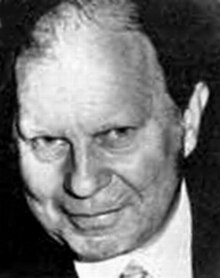Günther Glaser
Günther Glaser (born April 25, 1912 in Stuttgart ; † July 20, 2003 ibid) was a German physicist , engineering scientist and university professor .
Life
Günther Glaser was born in Stuttgart, spent his youth there and attended the secondary school in Eßlingen am Neckar .
He then studied physics, first at the TH Stuttgart , where he also graduated , then turned to the University of Göttingen , around 1936 with Robert Wichard Pohl with a thesis on electrical observations in the optical formation and regression of color centers in KBr and KCl -Crystals to PhD . Between 1936 and 1938 Günther Glaser worked as an assistant at the University of Göttingen and the TH Stuttgart, then in a research laboratory at Bosch .
He experienced the Second World War as a battalion and regimental adjutant with the mountain troops until the war finally released him in 1943 with two wounds.
After the Second World War he worked at the " German Research Institute for Gliding " (DFS) and at the " Württembergische Metallwarenfabrik " (WMF) in Geislingen an der Steige . In 1949 he went back to the university again, he became an assistant to Erich Regener at the Physics Institute of the TH Stuttgart.
In 1953 Günther Glaser went to Junghans in Schramberg , where he came into contact with watch technology, an area that never left him. A little later, he was given responsibility for research and development . During his time as Head of Development, the major technological change from the mechanical to the battery-powered electric clock took place .
In 1963, Günther Glaser accepted the call from the Technical University of Stuttgart to the chair for “Clock Technology and Precision Mechanics ”, later called “Institute for Time Measurement, Precision and Microtechnology” (IZFM). In addition, he headed the “Research Institute for Watch and Fine Appliance Technology” of the company of the same name, later renamed the Hahn-Schickard Society . The combination of research and teaching was in line with Günther Glaser's inclinations and he devoted himself to this task with the drive that characterizes him. Under his leadership, the watch technology institute and research institute made a variety of suggestions and developed the basis for new developments; corresponding publications confirm the high level of their research.
In 1981 Günther Glaser retired from active service.
In addition to his honorary duties in scientific committees, he felt particularly close to the German Chronometry Society , of which he was president from 1963 to 1981.
After a long illness, he died in Stuttgart in 2003 at the age of 92.
Awards and honors
- Federal Cross of Merit 1st class
- Jules Haag Medal from the Societe Chronometrique de France
- Philip-Matthäus-Hahn -medal of the German Society for Chronometry
- Honorary President of the German Chronometry Society (1982)
- 1980 VDE Ring of Honor
Patents
- 1957 DE No. 1.208.699 A method for compensating the temperature dependency of the rate of a clock operated contactlessly with a transistor circuit and a clock suitable for carrying out the method .
- 1958 DE No. 1.158.453 Contactlessly controlled aisle folder arrangement for time-keeping devices, especially electrical clocks .
Publications
More than 100 publications are known. The culmination of his life's work is the 16-volume he wrote in the 1980s
- Manual for chronometry and watch technology. Wilhelm Kempter KG, Ulm - on the completion of which he was still working many years after his retirement .
Further publications:
- Lexicon of watch technology. Wilhelm Kempter KG, Ulm 1974, ISBN 3-921348-13-7 .
- Quartz watch technology Wilhelm Kempter KG, Ulm 1974, ISBN 3-921348-24-2 .
Web links
- Stuttgart unique courier: Günther Glaser
Individual evidence
- ↑ Friedrich Assmus: On the death of Prof. em. Dr. phil. Günther Glaser in communications from the German Society for Chronometrie, No. 92, Winter 2003, p. 2f.
- ↑ Transmitter: Magazine of the Faculties of Stuttgart Mechanical Engineering , No. 3, 2008, p. 65.
| personal data | |
|---|---|
| SURNAME | Glaser, Günther |
| BRIEF DESCRIPTION | German physicist, engineering scientist and university professor |
| DATE OF BIRTH | April 25, 1912 |
| PLACE OF BIRTH | Stuttgart |
| DATE OF DEATH | July 20, 2003 |
| Place of death | Stuttgart |
